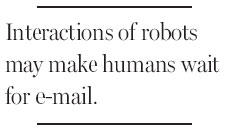Mechanized dialogue
Updated: 2012-08-13 13:14
By Kevin J. O'Brien (The New York Times)
|
|||||||||||
About a third of machine-to-machine communication involves so-called smart utility meters, which perform duties like sending data on household electric and gas consumption to utilities; the utilities use the information to tailor production to actual demand. In Europe, all households in Sweden and Italy are equipped with smart meters, many of them running wirelessly. In Austria, a law will require five million homes to be equipped with smart electric meters by 2019.

Another third is taking place in the auto industry, through car and truck fleet management systems, which allow transport companies or corporate car managers to track their vehicles in real time. Machine-to-machine communication is also used by emergency accident, repair and location services like General Motors' OnStar system, now installed on a quarter of new GM vehicles.
In Europe, similar technology is beginning to appear in preparation for 2015, when the eCall initiative, a European Union law requiring all new cars to be equipped with wireless transmitters, will take effect.
The transmitters would automatically report accident data, as well as airbag deployment and location, to emergency responders.
But it is variations on consumer applications like Ocado's that are expected to provide the biggest growth over the next decade, said Yiru Zhong, an analyst at Frost & Sullivan, a research firm in London that tracks the sector.
For example, the Japanese government is considering installing a bigger system of seismic sensors to detect earthquakes, Ms. Zhong said.
In Calitri, a town in southern Italy, wireless sensors are helping produce caciocavallo, a type of Pecorino cheese made by Caseificio di Cecca e di Roma. The cheeses age in cellars, shielded from the searing heat, and sensors regularly send data on humidity to a monitoring station.
European mobile operators have begun exploiting the financial potential of machine-to-machine communication, and have set up independent units to develop the business. Telefonica, Deutsche Telekom, Vodafone and France Telecom have all established separate business entities or internal centers to develop new products catering to machines.
Ms. Zhong estimated that machine-to-machine conversations on average made up less than 10 percent of an operator's total revenue, but the growth potential is considered large.
For wireless machine communication to become ubiquitous - imagine every home or office window opening and closing automatically to control temperature and humidity - the makers of the modules, SIM cards and associated network equipment will have to agree on a broad series of technical standards.
"Most mobile networks are set up for human communication, not for machines," said Tobias Ryberg, an analyst at Berg Insight. "So there will have to be a whole revamping of the system to make this possible."
The New York Times
Related Stories
Qinghai benefits from medical system reform 2012-07-30 09:23
Cultural investment system takes shape 2012-06-19 14:47
Elementary school system advances 2012-04-25 14:30
New system solves record number of criminal cases 2012-06-12 10:34
Houston drowned with cocaine in system 2012-03-23 10:04
Today's Top News
Rescuers race against time for quake victims
Telecom workers restore links
Coal mine blast kills 18 in Jilin
Intl scholarship puts China on the map
More bird flu patients discharged
Gold loses sheen, but still a safe bet
US 'turns blind eye to human rights'
Telecom workers restore links
Hot Topics
Lunar probe , China growth forecasts, Emission rules get tougher, China seen through 'colored lens', International board,
Editor's Picks

|

|

|

|

|

|





